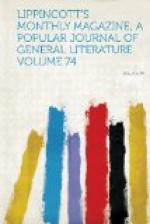The getting up of a World’s Fair was an afterthought; the original design having been simply an illustration of British industrial advancement, in friendly rivalry with that which was becoming, across the Channel, too brilliant to be ignored. The government’s contribution, in the first instance, was meagre enough—merely the use of a site. Rough discipline in youth is England’s system with all her bantlings. She is but a frosty parent if at bottom kindly, and, when she has a shadow of justification, proud. In the present instance she stands excused by the sore shock caused her conservatism by the conceit of a building of glass and iron four times as long as St. Paul’s, high enough to accommodate comfortably one of her ancestral elms, and capacious enough to sustain a general invitation to all mankind to exhibit and admire.
Novelty and innovation attended the first step of the great movement. The design of the structure made architects rub their eyes, and yet its origin was humble and practical enough. The Adam of crystal palaces, like him of Eden, was a gardener. When Joseph Paxton raised the palm-house at Chatsworth he little suspected that he was building for the world—that, to borrow a simile from his own vocation, he was setting a bulb which would expand into a shape of as wide note as the domes of Florence and St. Sophia. And the cost of his new production was so absurdly low—eighty thousand pounds by the contract. The cheapness of his plan was its great merit in the eyes of the committee, and that which chiefly determined its selection over two hundred and forty-four competitors. This new cathedral for the apotheosis of industry resembled those of the old worship in the attributes of nave, aisles and transepts; and these features have been, by reason in great degree of the requirements of construction, continued in its successors. Galleries were added to the original design to secure space additional to what was naturally deemed at first an ample allowance for all comers. Before ground had been well broken the demands of British exhibitors alone ran up to four hundred and seventeen thousand superficial feet instead of the two hundred and ten thousand—half the whole area—allotted them. The United States were offered forty thousand feet; France, fifty thousand, afterward increased to sixty-five; the Zollverein, thirty thousand, and India the same. A comparison of the whole number of exhibitors, as distributed between Great Britain




